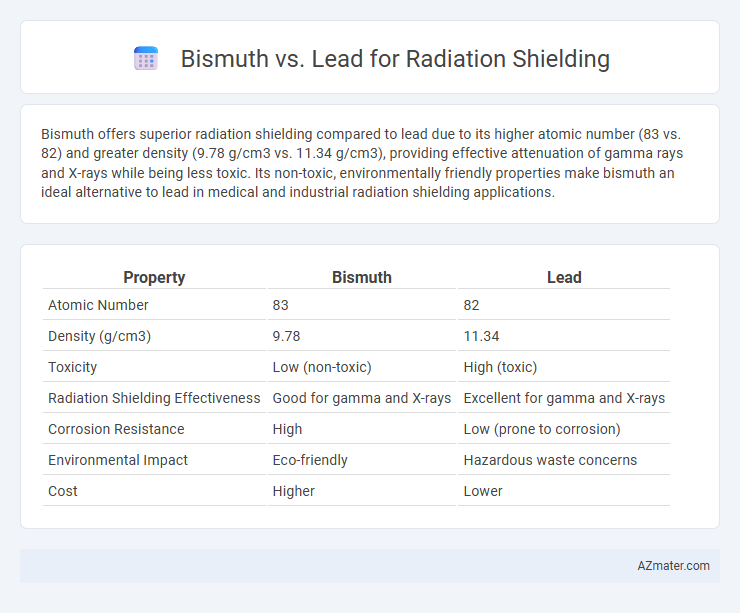Bismuth offers superior radiation shielding compared to lead due to its higher atomic number (83 vs. 82) and greater density (9.78 g/cm3 vs. 11.34 g/cm3), providing effective attenuation of gamma rays and X-rays while being less toxic. Its non-toxic, environmentally friendly properties make bismuth an ideal alternative to lead in medical and industrial radiation shielding applications.
Table of Comparison
| Property | Bismuth | Lead |
|---|---|---|
| Atomic Number | 83 | 82 |
| Density (g/cm3) | 9.78 | 11.34 |
| Toxicity | Low (non-toxic) | High (toxic) |
| Radiation Shielding Effectiveness | Good for gamma and X-rays | Excellent for gamma and X-rays |
| Corrosion Resistance | High | Low (prone to corrosion) |
| Environmental Impact | Eco-friendly | Hazardous waste concerns |
| Cost | Higher | Lower |
Introduction to Radiation Shielding Materials
Bismuth and lead are widely used materials in radiation shielding due to their high density and atomic number, which effectively attenuate harmful ionizing radiation such as gamma rays and X-rays. Bismuth offers a non-toxic, environmentally friendly alternative to lead, with comparable shielding efficiency but less health risk. Advances in material science have enhanced the use of bismuth composites, providing durable and sustainable options for medical, industrial, and nuclear applications demanding reliable radiation protection.
Properties of Bismuth as a Shielding Material
Bismuth offers superior radiation shielding properties compared to lead, with a high atomic number (83) and density (9.78 g/cm3) that effectively attenuate gamma rays and X-rays. Its non-toxic, environmentally friendly nature makes it preferable for medical and industrial shielding applications. Bismuth's low thermal conductivity and excellent corrosion resistance enhance durability while minimizing health risks associated with lead exposure.
Properties of Lead as a Shielding Material
Lead is a highly effective radiation shielding material due to its high density of 11.34 g/cm3, which provides excellent attenuation of gamma rays and X-rays. Its atomic number of 82 allows for significant photoelectric absorption, making it superior in blocking ionizing radiation compared to many other metals. The malleability and relatively low cost of lead further enhance its practicality for use in protective gear, medical imaging rooms, and nuclear facilities.
Comparative Atomic Structure: Bismuth vs Lead
Bismuth and lead, both heavy metals with high atomic numbers, differ in atomic structure, impacting their effectiveness in radiation shielding. Bismuth has an atomic number of 83 and a denser electron cloud configuration compared to lead's atomic number 82, resulting in slightly higher photon attenuation efficiency. The difference in electron density and atomic mass makes bismuth a more environmentally friendly and less toxic alternative while maintaining comparable shielding performance.
Density and Attenuation Efficiency
Bismuth has a density of approximately 9.78 g/cm3, which is lower than lead's density of 11.34 g/cm3, yet it offers comparable radiation shielding due to its high atomic number (83). The attenuation efficiency of bismuth is effective for gamma and X-ray radiation, closely matching that of lead while being less toxic and more environmentally friendly. Despite its slightly lower density, bismuth's attenuation coefficient ensures efficient shielding performance, making it a viable alternative to lead in radiation protection applications.
Toxicity and Environmental Impact
Bismuth offers a non-toxic and environmentally friendly alternative to lead for radiation shielding, as it is less harmful when ingested or inhaled and does not bioaccumulate in ecosystems. Unlike lead, which poses significant health risks including neurological damage and environmental contamination through soil and water, bismuth exhibits low toxicity and is considered safe for medical and industrial applications. The biodegradability and lower chemical reactivity of bismuth further reduce its environmental impact, making it a preferred choice for sustainable radiation shielding solutions.
Cost Considerations and Availability
Bismuth offers a non-toxic alternative to lead for radiation shielding but at a higher cost, which can impact budget-sensitive projects. Lead remains widely available and affordable, making it the preferred choice for large-scale or cost-constrained applications despite its toxicity concerns. The supply chain for bismuth is more limited due to its primary use in specialty alloys and pharmaceuticals, potentially leading to availability challenges compared to lead's extensive industrial production.
Applications in Medical and Industrial Settings
Bismuth offers superior radiation shielding properties compared to lead due to its higher atomic number and greater density, making it highly effective in medical imaging and radiotherapy applications. In industrial settings, bismuth-based shielding materials reduce toxic exposure risks associated with lead, enhancing workplace safety while maintaining protection against X-rays and gamma rays. Innovations in bismuth composites support eco-friendly designs for protective barriers, ensuring compliance with stringent health and environmental regulations.
Innovations and Emerging Trends
Bismuth is gaining prominence in radiation shielding due to its non-toxicity and high atomic number, offering an eco-friendly alternative to traditional lead shields. Innovations include composite materials combining bismuth with polymers or ceramics to enhance flexibility and durability while maintaining effective gamma and X-ray attenuation. Emerging trends focus on lightweight, wearable radiation shields using bismuth nanoparticles, improving protection for medical personnel and workers in nuclear industries.
Choosing the Right Material for Radiation Protection
Bismuth offers a non-toxic, environmentally friendly alternative to lead for radiation shielding, making it ideal for medical and laboratory applications requiring safer materials. Lead remains widely used due to its high density and excellent attenuation properties, effectively blocking gamma and X-rays in industrial and nuclear settings. Selecting between bismuth and lead depends on factors such as toxicity concerns, shielding efficiency, weight requirements, and regulatory restrictions governing radiation protection materials.

Infographic: Bismuth vs Lead for Radiation shielding
 azmater.com
azmater.com